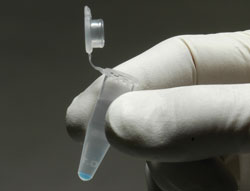Raf-RBD beads (binds active Ras protein)
Product Uses Include
- Measurement of the GTP/GDP ratio of Ras in vitro.
- Quantitation of GTP-Ras from tissue and tissue culture cell lysates.
Material
The Ras binding domain (RBD) of the c-Raf kinase protein (Raf) protein has been expressed as a GST-fusion protein in E. coli. This protein binds binds specifically to GTP-bound, and not GDP-bound, Ras proteins. The domain can therefore be used to specifically precipitate active, GTP-bound Ras as well as to specifically block the activity of Ras in vitro and in vivo.
The protein is supplied in a glutathione agarose bound format and is shipped lyophilized. The beads are colored for ease of use. This product is used in our Ras activation assay Biochem Kit™ (Cat. # BK008). The GST-tagged Raf-RBD protein can be released from the beads by incubation with 10 mM reduced glutathione.

Figure 1. The brightly colored glutatione agarose beads in RF02 are easy to use.
Purity
Protein purity is determined by scanning densitometry of Coomassie Blue stained protein on a 12% SDS polyacrylamide gel. GST-Raf-RBD protein is >80% pure (see Figure 2).

Figure 2: GST-Raf-RBD protein purity determination. A 20 µg sample of RF02 was separated by electrophoresis in a 12% SDS-PAGE system and stained with Coomassie Blue. The GST-Raf-RBD protein runs at approximately 35 kDa.
Biological Activity
Raf-RBD protein specifically recognizes and binds the active, GTP-bound, forms of Ras proteins. It has a much lower affinity for the inactive, GDP-bound, form Ras. When coupled to a colored glutathione sepharose matrix, the Raf-RBD protein beads become a convienent tool for assaying the activity of the Ras proteins. The quality control biological assay for Raf-RBD protein beads consists of a Ras protein pulldown frombovine brain extracts loaded with either GTPγS (Cat. # BS01) or GDP.
For product Datasheets and MSDSs please click on the PDF links below. For additional information, click on the FAQs tab above or contact our Technical Support department at tservice@cytoskeleton.com
Coming soon! If you have any questions concerning this product, please contact our Technical Service department at tservice@cytoskeleton.com

